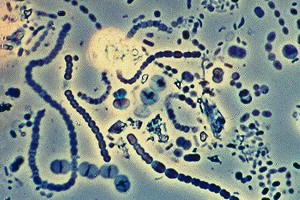Methylococcus capsulatus
A Microbial Biorealm page on the genus Methylococcus capsulatus
Classification
Higher order taxa
Kingdom: Bacteria Domain: Proteobacteria Phylum: Gammaproteobacteria Class: Methylococcales Order: Methylococcaceae Family: Methylococcus
Species
- Genus: Methylococcus
- Species: capsulatus
Description and significance
Methylococcus capsulatus is a methylotrophic “Gram-negative” bacterium with coccus shape, live in multiple habitats, however, oxygen is a necessity for such cell to survive. Methylococcus capsulatus is also a thermophilic microbe which optically live in the temperature of 45C.
Methylococcus capsulatus is isolated from Methanotrophic bacterium, which serves a unique biological function in earth's environment. Methanotrophic bacteria is able to generate Green House gas, Methane, as an energy source for growth (detail mechanism refer to section, cell structure and metabolism), and contribute to lower the methane level in earth's atmosphere.

Genome structure
"The genome of M. capsulatus (Bath) comprises a single circular molecule of 3,304,697 bp."
Methylocuccus capsulatus a Gram-Negative microbe with linear structure.
Cell structure and metabolism
"Methylococcus capsulatus is a methanotroph (Methane-oxidising bacteria.) Methanotrophs are ubiquitous Gram-negative bacteria that can use the greenhouse gas methane as a sole carbon and energy source for growth, thus playing major roles in global carbon cycles, and in particular, substantially reducing emissions of biologically generated methane to the atmosphere."
"Methanotrophs are also able to metabolize or co-metabolize xenobiotic compounds, including chlorinated solvents such as trichloroethylene, and hence have potential as bioremediation tools."
Ecology
"Methylococcus capsulatus (Bath) is the first complete genome sequence reported from an obligate methanotroph. Genome analysis suggests the ability of M. capsulatus to scavenge copper (including a previously unreported nonribosomal peptide synthetase) and to use copper in regulation of methanotrophy, but the exact regulatory mechanisms remain unclear."
Pathology
The research of disease cause by Methylococcus capsulatus is still in discovering.
Application to Biotechnology
Methylococcus capsulatus Bath has in common with all of the genomes in the CMR (not including itself), based on all v/s all searches. Each dot on the plot below represents a "match" organism in the CMR. The X-axis value is the total number of genes in each match organism. The Y-axis value is the number of "Best Protein Hits" between the match organism and Methylococcus capsulatus Bath, based on the all v/s all blast searches. The "Best Protein Hit" for each Methylococcus capsulatus Bath protein is determined by the protein or proteins from the blast search that have the lowest P value. Below the graph is a table listing all of the organisms in the CMR and the number of "Best Protein Hits" between the match organism and Methylococcus capsulatus Bath.
Current Research
Arch Microbiol. 2005 Nov 26; :1-16 16311759
Analysing the outer membrane subproteome of Methylococcus capsulatus (Bath) using proteomics and novel biocomputing tools. Frode Berven , Odd Karlsen , Anne Straume , Kristian Flikka , J Murrell , Anne Fjellbirkeland , Johan Lillehaug , Ingvar Eidhammer , Harald Jensen High-resolution two-dimensional gel electrophoresis and mass spectrometry has been used to identify the outer membrane (OM) subproteome of the Gram-negative bacterium Methylococcus capsulatus (Bath). Twenty-eight unique polypeptide sequences were identified from protein samples enriched in OMs. Only six of these polypeptides had previously been identified. The predictions from novel bioinformatic methods predicting beta-barrel outer membrane proteins (OMPs) and OM lipoproteins were compared to proteins identified experimentally. BOMP ( http://www.bioinfo.no/tools/bomp ) predicted 43 beta-barrel OMPs (1.45%) from the 2,959 annotated open reading frames. This was a lower percentage than predicted from other Gram-negative proteomes (1.8-3%). More than half of the predicted BOMPs in M. capsulatus were annotated as (conserved) hypothetical proteins with significant similarity to very few sequences in Swiss-Prot or TrEMBL. The experimental data and the computer predictions indicated that the protein composition of the M. capsulatus OM subproteome was different from that of other Gram-negative bacteria studied in a similar manner. A new program, Lipo, was developed that can analyse entire predicted proteomes and give a list of recognised lipoproteins categorised according to their lipo-box similarity to known Gram-negative lipoproteins ( http://www.bioinfo.no/tools/lipo ). This report is the first using a proteomics and bioinformatics approach to identify the OM subproteome of an obligate methanotroph.
Reference
Guengerich, F. P. (1991) J. Biol. Chem. 266, 10019-10022
Nelson, D. R., Koymans, L., Kamataki, T., Stegeman, J. J., Feyereisen, R., Waxman, D. J., Waterman, M. R., Gotoh, O., Coon, M. J., Estabrook, R. W., Gunsalus, I. C., and Nebert, D. W. (1996) Pharmacogenetics
Bird, C. W., Lynch, J. M., Pirt, F. J., Reid, W. W., Brooks, C. J. W., and Middleditch, B. S. (1971) Nature
Degtyarenko, K. N., and Archakov, A. I. (1993) FEBS Lett
Nakayama, N., Takemae, A., and Shoun, H. (1996) J. Biochem. (Tokyo)
Shet, M. S., Fisher, C. W., Holmans, P. L., and Estabrook, R. W. (1993) Proc. Natl. Acad. Sci. U. S. A
Bellamine, A., Mangla, A. T., Nes, W. D., and Waterman, M. R. (1999) Proc. Natl. Acad.
Edited by Ting Yuan Feng, student of Rachel Larsen at UCSD.Sci. U. S. A.
